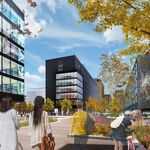Johnny Au
Senior Member
If the heated platforms are walled in with doors, then it would get very humid in there, with so much condensation forming on the outside of the walls.

Maybe heating the platforms up to +4°C (when needed) would be enough to melt the snow or ice, would be enough to have a "warm" feeling to our feet. It's our feet that needs the heating, and heat flows up, better than having heating pads overhead. They do with with driveways (especially condo and apartment driveways), how about giving transit users their turn?


Sorry, are transit users now complaining about not having heated floors at OUTDOOR bus stops???
They may not be complaining, but presumably there's a reduction in the use of sand and salt - and that means longer life expectancy for the platforms and hopefully vehicle interiors too. So money well spent.
- Paul

This may come sooner than you think and in a way you wouldn't have imagined!I wish all our sidewalks and roads were heated in the winter. It would not only eliminate our need for salt (which destroys both), but it would make mobility so much easier for all. Fewer lives would also be lost due to icey road conditions. I wonder what the discrepancy in cost would be to implement this on all roads and sidewalks vs. spending money on salt and the labour involved with its distribution. How much longer would roads and sidewalks last if they didn't bulge and crack each year, resulting in uneven surfaces and potholes. Our current system isn't very good and requires far too much maintenance.
You do know that heated driveways in condos and buildings come from the building's boilers....Please tell me where you plan to have heat come from? Its not like there can be hot water or even electric heating magically popping out of the ground to tap readily into.



Presentation To Government Management Committee, Toronto City Council -- May 12, 2014
The Ontario Science Centre is eagerly looking forward to the arrival of the Eglinton LRT and the subsequent inevitable development of the Don Mills and Eglinton intersection. This will bring significant opportunities for the city, our local community and the Centre. Should a downtown relief line be built, our intersection has the potential to become an even more major hub.
Over the past few years we have heard indirectly of a number of options for the city owned land that we currently use as the overflow parking lot at the Ontario Science Centre. These have ranged from a dual pad hockey arena, to a staging area for the LRT tunnel, to a LRT station and, most recently, back to the hockey
arena proposal. It is our understanding that the latter is now being seriously considered by your committee and we believe it is important that we participate in that discussion.
The Ontario Science Centre’s preference would be to participate in a more strategic assessment of development opportunities for the Don Mills and Eglinton area that would consider carefully what form of development
would best serve the city, the local community and OSC.
Should the decision be made to build a dual pad arena on the southwest corner of the intersection, based on the immediate need to replace Don Mills arena by 2019, we will lose that opportunity to consider what will best serve the long term interests of what will soon be a new major hub in our city.
Our preference is for a planning study to be done, to include all stakeholders including the Ontario Science Centre, that would anticipate opportunities and risks over the next few decades. If the decision is made
to build an arena, it will negate the opportunity to consider other options for what the four corners of Don Mills and Eglinton might become.
We also have a more operational concern with any decision to build a dual pad arena. Since most parents drive children and their large equipment bags to hockey, we must raise the serious question of parking. There is no public parking in our neighbourhood (paid or on street) other than in the Ontario Science Centre lots. The Centre currently uses the “upper north”overflow lot 25-30 days annually on our busiest days.
The loss of those parking spaces is projected to result in a reduction of 30,000 visitors and associated revenue annually (3% of overall visitation to the Centre).
Our greater concern however is the demand for parking that will come from arena users. If those cars try to park in our already very busy “lower north” and south lots, it will further reduce parking for our own visitors.
This will be a serious operational issue for us, further impacting visitation and earned revenue. We are confident that the City would not want the arena decision to have such a major negative impact on one of Toronto’s most visited attractions.
The Ontario Science Centre looks forward to the changes in our local community with the advent of improved transit and would be delighted to work with you, city staff and other interested parties to consider how best to capitalize on these opportunities.




